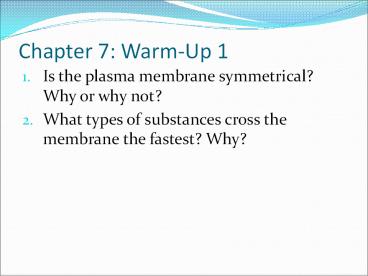Chapter 7: Warm-Up 1 - PowerPoint PPT Presentation
1 / 36
Title:
Chapter 7: Warm-Up 1
Description:
Chapter 7: Warm-Up 1 Is the plasma membrane symmetrical? Why or why not? What types of substances cross the membrane the fastest? Why? Bulk Transport Transport of ... – PowerPoint PPT presentation
Number of Views:111
Avg rating:3.0/5.0
Title: Chapter 7: Warm-Up 1
1
Chapter 7 Warm-Up 1
- Is the plasma membrane symmetrical? Why or why
not? - What types of substances cross the membrane the
fastest? Why?
2
Chapter 7 Warm-Up 2
- What are glycoproteins and glycolipids and what
is their function? - How do hydrophilic substances cross the cell
membrane? - Why does water move through the bi-layer quickly?
3
Chapter 7 Warm-Up 3
- Explain membrane potential and how it affects the
cell. - In a U-tube, side A has 4 M glucose and 2 M NaCl.
Side B has 2M glucose and 6 M NaCl. Initially,
side A is ____ to side B - and side B is ____ to side A. What happens if
the membrane is permeable to both solutes? Only
permeable to water and NaCl?
4
Chapter 7 Warm-Up 4
- Side A in a U tube has 5M sucrose and 3 M
glucose. Side B has 2 M sucrose and 1 M glucose.
The membrane is permeable to glucose and water
only. What happens to each side?
5
Chapter 7 Warm-Up 5
- Side A in a U tube has 3 M sucrose and 1 M
glucose. Side B has 1 M sucrose and 3 M glucose.
The membrane is permeable to glucose and water
only. What happens to each side?
6
Chapter 7
- Membrane Structure and Function
7
What You Must Know
- Why membranes are selectively permeable.
- The role of phospholipids, proteins, and
carbohydrates in membranes. - How water will move if a cell is placed in an
isotonic, hypertonic, or hypotonic solution. - How electrochemical gradients are formed.
8
Cell Membrane
- Plasma membrane is selectively permeable
- Allows some substances to cross more easily than
others - Fluid Mosaic Model
- Fluid membrane held together by weak
interactions - Mosaic phospholipids, proteins, carbs
9
Early membrane model
- (1935) Davson/Danielli Sandwich model
- phospholipid bilayer between 2 protein layers
- Problems varying chemical composition of
membrane, hydrophobic protein parts
10
The freeze-fracture method revealed the
structure of membranes interior
11
Fluid Mosaic Model
12
(No Transcript)
13
Phospholipids
- Bilayer
- Amphipathic hydrophilic head, hydrophobic tail
- Hydrophobic barrier keeps hydrophilic molecules
out
14
Membrane fluidity
- Low temps phospholipids w/unsaturated tails
(kinks prevent close packing) - Cholesterol resists changes by
- limit fluidity at high temps
- hinder close packing at low temps
- Adaptations bacteria in hot springs (unusual
lipids) winter wheat (? unsaturated
phospholipids)
15
Membrane Proteins
- Integral Proteins
- Peripheral Proteins
- Embedded in membrane
- Determined by freeze fracture
- Transmembrane with hydrophilic heads/tails and
hydrophobic middles
- Extracellular or cytoplasmic sides of membrane
- NOT embedded
- Held in place by the cytoskeleton or ECM
- Provides stronger framework
16
Integral Peripheral proteins
17
Transmembrane protein structure
Hydrophobic interior
Hydrophilic ends
18
Some functions of membrane proteins
19
Carbohydrates
- Function cell-cell recognition developing
organisms - Glycolipids, glycoproteins
- Eg. blood transfusions are type-specific
20
Synthesis and sidedness of membranes
21
Selective Permeability
- Small molecules (polar or nonpolar) cross easily
(hydrocarbons, hydrophobic molecules, CO2, O2) - Hydrophobic core prevents passage of ions, large
polar molecules
22
Passive Transport
- NO ENERGY needed!
- Diffusion down concentration gradient (high ? low
concentration) - Eg. hydrocarbons, CO2, O2, H2O
23
(No Transcript)
24
Osmosis diffusion of H2O
25
External environments can be hypotonic, isotonic
or hypertonic to internal environments of cell
26
Osmoregulation
- Control solute water balance
- Contractile vacuole bilge pump forces out
fresh water as it enters by osmosis - Eg. paramecium caudatum freshwater protist
27
Facilitated Diffusion
- Transport proteins (channel or carrier proteins)
help hydrophilic substance cross
- (1) Provide hydrophilic channel or (2) loosely
bind/carry molecule across - Eg. ions, polar molecules (H2O, glucose)
28
Aquaporin channel protein that allows passage of
H2O
29
Glucose Transport Protein (carrier protein)
30
Active Transport
- Requires ENERGY (ATP)
- Proteins transport substances against
concentration gradient (low ? high conc.) - Eg. Na/K pump, proton pump
31
Electrogenic Pumps generate voltage across
membrane
- Na/K Pump
- Proton Pump
- Pump Na out, K into cell
- Nerve transmission
- Push protons (H) across membrane
- Eg. mitochondria (ATP production)
32
Cotransport membrane protein enables downhill
diffusion of one solute to drive uphill
transport of other
- Eg. sucrose-H cotransporter (sugar-loading in
plants)
33
Passive vs. Active Transport
- Little or no Energy
- High ? low concentrations
- DOWN the concentration gradient
- eg. diffusion, osmosis, facilitated diffusion
(w/transport protein)
- Requires Energy (ATP)
- Low ? high concentrations
- AGAINST the concentration gradient
- eg. pumps, exo/endocytosis
34
(No Transcript)
35
Bulk Transport
- Transport of proteins, polysaccharides, large
molecules
Endocytosis take in macromolecules, form new
vesicles
Exocytosis vesicles fuse with cell membrane,
expel contents
36
Types of Endocytosis
Phagocytosis cellular eating - solids
Pinocytosis cellular drinking - fluids
Receptor-Mediated Endocytosis Ligands bind to
specific receptors on cell surface
37
BioFlix Animation
- Membrane Transport































